Bulk Data Enrichment: Process 10,000+ Records in Minutes
How to Enrich Thousands of B2B Records Quickly Without Sacrificing Data Quality
Blogby JanAugust 04, 2025

Your CRM shows 50,000 contacts, but the reality is sobering: 40% lack phone numbers, email addresses are bouncing at 15%, and company information is missing or outdated for thousands more. This isn't just a data problem - it's a revenue problem that's costing your team deals every single day.
B2B data decays at 30% annually, meaning nearly one-third of your carefully built database becomes worthless each year. Manual enrichment for even 10,000 records would consume 333+ hours of labor time. Traditional automation tools processing one record at a time still require days to complete what modern bulk enrichment accomplishes in hours.
The solution isn't working harder - it's working systematically. Modern bulk data enrichment platforms can process 10,000+ records in under four hours while maintaining accuracy rates that match or exceed manual research. More importantly, they do it at a fraction of the cost.
We'll show you exactly how bulk enrichment turn incomplete databases into sales-ready assets, which platforms deliver the best results, and how to implement a system that processes massive datasets without sacrificing quality.
Cost of Incomplete B2B Data
Most sales teams underestimate how much incomplete data actually costs them. The numbers tell a different story than what appears in your CRM dashboard.
Time waste multiplies exponentially. SiriusDecisions research shows that sales reps spend 27% of their time dealing with bad data - that's more than 10 hours per week for full-time salespeople. For a team of 10 reps earning $80,000 annually, bad data costs approximately $216,000 in lost productivity alone.
Email campaigns suffer dramatically. Invalid email addresses don't just fail to deliver - they damage your sender reputation with email providers. Bounce rates above 5% can land your domain on spam lists, affecting even your valid emails. Companies with clean email lists see 25% higher open rates and 40% better deliverability compared to those using outdated data.
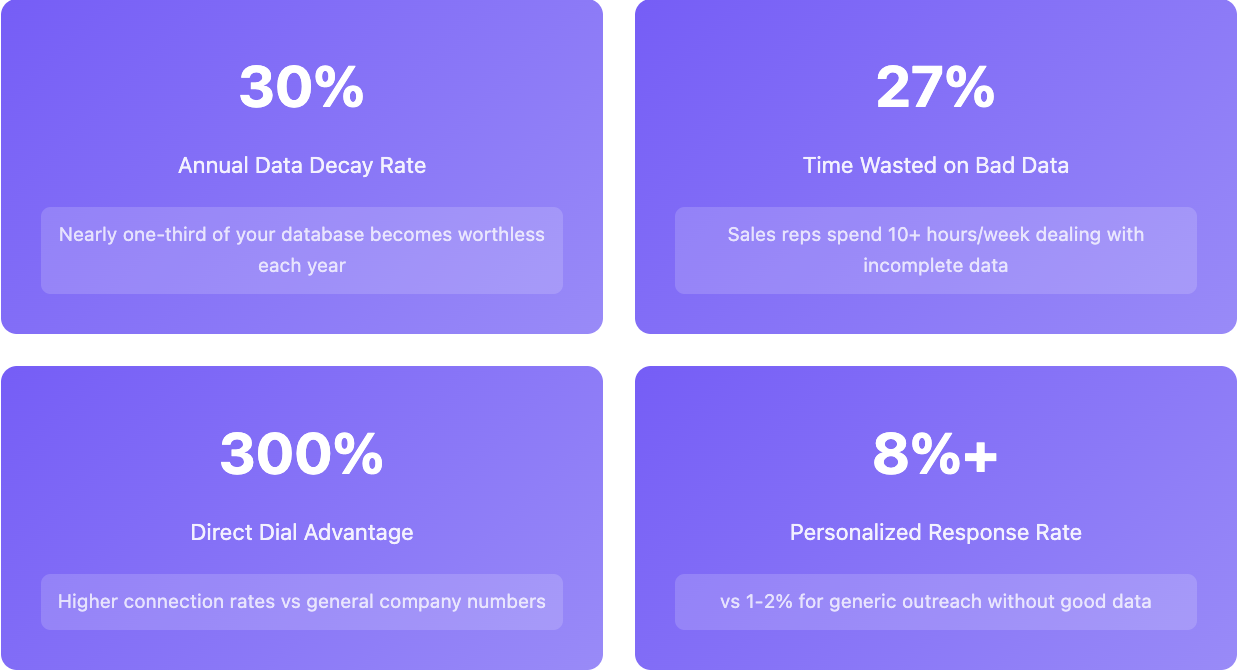
Phone outreach becomes unproductive. Without direct dial numbers, sales reps resort to calling main company lines, facing gatekeepers and wasting valuable selling time. Studies show that direct dial numbers increase connection rates by 300% compared to general company numbers.
Personalization becomes impossible. Generic outreach converts at 1-2%, while personalized messages based on accurate company data can achieve 8%+ response rates. Without current job titles, company size, or industry information, every message sounds like mass marketing.
The math is simple: incomplete data doesn't just slow you down - it actively prevents revenue generation. Teams that invest in comprehensive data enrichment typically see 25-40% increases in qualified opportunities within 90 days.
What are Modern Bulk Enrichment Systems?
Bulk enrichment fundamentally differs from traditional data tools through parallel processing and intelligent data orchestration. Instead of handling records sequentially, modern systems split large datasets into optimized batches that process simultaneously across multiple servers.
The technical architecture matters. When you upload 10,000 records, sophisticated platforms don't process them one by one. They split your file into 100 batches of 100 records, then process all batches simultaneously. This parallel approach reduces processing time from days to hours.
Multi-source querying provides superior coverage. The best bulk enrichment platforms don't rely on single data providers. They query multiple databases simultaneously - if Provider A lacks a phone number, the system automatically checks Providers B, C, and D. This waterfall approach typically improves match rates from 45-60% (single source) to 75-90% (multi-source).
Real-time quality validation ensures accuracy. As data returns from various sources, modern systems perform immediate validation. Email syntax checking, phone number format verification, and cross-reference validation happen instantly. Each data point receives a confidence score, allowing you to set minimum quality thresholds.
Consider how Databar.ai's waterfall enrichment approach handles a typical request: when enriching contact information, the system simultaneously queries 15+ email providers, 12+ phone databases, and 20+ company data sources. If the first email provider returns no result, the system automatically tries the next provider without human intervention.
Smart deduplication prevents waste. Before enrichment begins, AI algorithms identify and merge duplicate records. "John Smith at Acme Corp" and "J. Smith at Acme Corporation" are recognized as identical, preventing redundant processing and credit waste.
The result is enrichment that's both faster and more accurate than manual research, processing thousands of records with precision that individual tools can't match.
Strategic Implementation: Building Your Bulk Enrichment Workflow
Successful bulk enrichment requires systematic preparation and intelligent prioritization. Teams that jump directly into processing without preparation typically see 30-40% lower match rates and waste significant credits on low-value records.
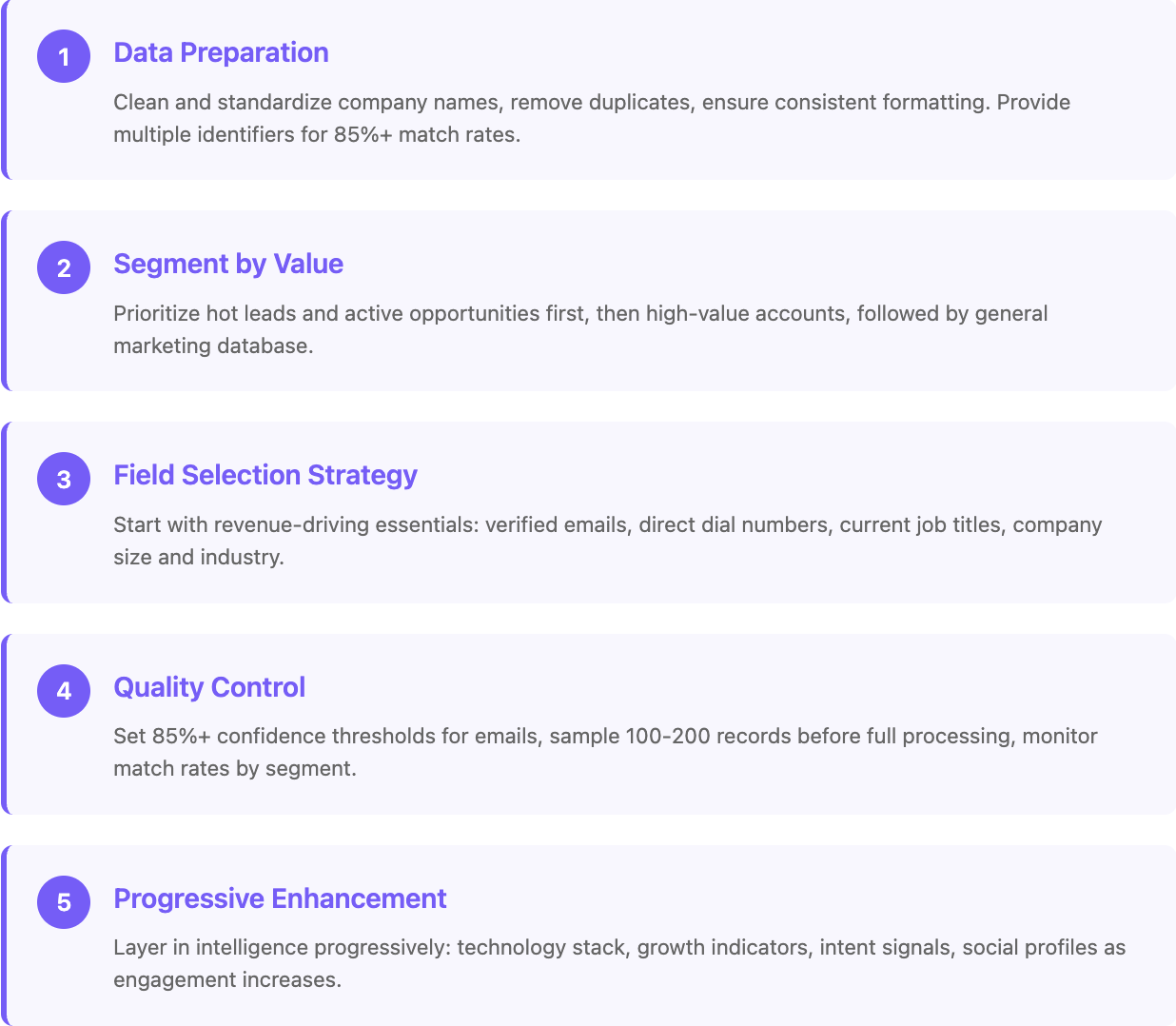
Data Preparation: The Foundation of Success
Clean before you enrich. Standardize company names, remove obvious duplicates, and ensure consistent formatting. "International Business Machines," "IBM," and "IBM Corporation" should all be standardized to "IBM" before processing. This simple step improves match rates by 15-25%.
Provide multiple identifiers when possible. Records with only a name might achieve 30% match rates, while records including name + company + domain can exceed 85%. The enrichment hierarchy typically follows this pattern:
- Name + LinkedIn URL: 95% match rate
- Name + Company + Email Domain: 85% match rate
- Name + Company Name: 60% match rate
- Name + Job Title: 45% match rate
- Name Only: 25% match rate
Segment by value and urgency. Don't enrich everything simultaneously. Prioritize based on revenue impact:
- Hot leads and active opportunities - immediate enrichment with full data profiles
- High-value target accounts - comprehensive enrichment including technographics and intent data
- General marketing database - basic contact and company information
Field Selection Strategy
Start with revenue-driving essentials. Focus initial enrichment on data that directly impacts pipeline generation:
- Verified email addresses for marketing campaigns
- Direct dial phone numbers for sales outreach
- Current job titles for personalization
- Company size and industry for segmentation
Layer in intelligence progressively. Once core contact data is complete, enhance with behavioral and predictive signals:
- Technology stack information for solution positioning
- Recent funding or growth indicators for timing
- Intent signals showing active research
- Social media profiles for relationship building
Avoid over-enrichment initially. Teams often try to capture every possible data point in the first pass. This approach increases costs without proportional benefits. Better to achieve 90% coverage on essential fields than 60% coverage on comprehensive profiles.
Quality Control
Set appropriate confidence thresholds. Configure minimum confidence scores for each data type. Email addresses should typically require 85%+ confidence, while less critical fields like secondary phone numbers might accept 70%+ confidence.
Sample before full processing. Run 100-200 records through your complete workflow before processing thousands. This sample reveals mapping issues, quality problems, and optimization opportunities without wasting credits.
Monitor match rates by segment. Track enrichment success by industry, company size, and geography. Manufacturing companies might show different match rates than technology startups, indicating need for specialized data sources or different identifier strategies.
Advanced Techniques for Maximum Coverage
Once you've mastered basic bulk enrichment, these advanced strategies can push match rates above 90% while optimizing costs.
Cascade Enrichment Methodology
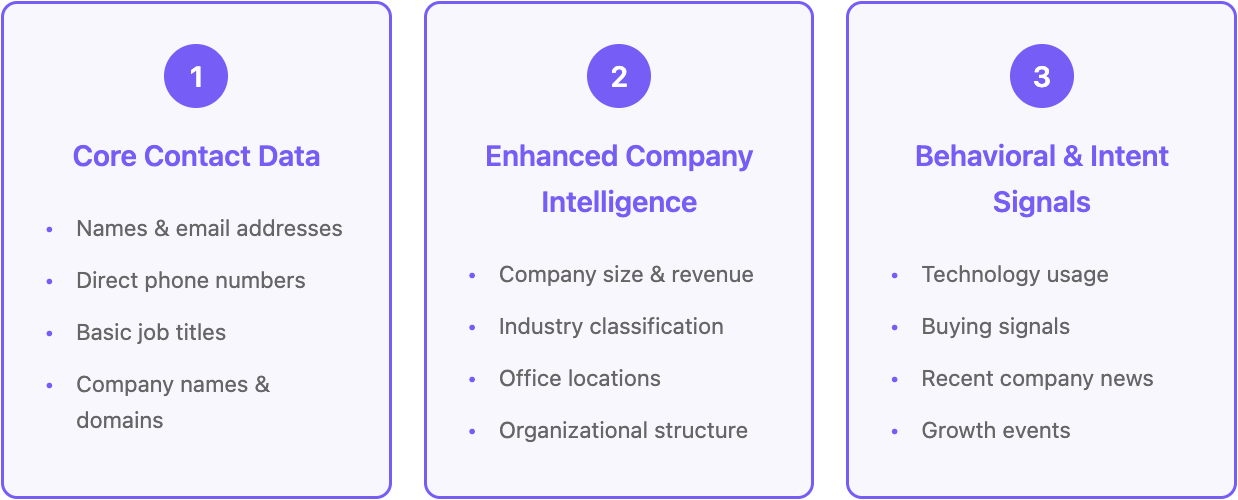
Process in strategic waves rather than attempting complete enrichment in single passes. This approach maximizes both match rates and cost efficiency:
Wave 1: Core Contact Data
- Names, email addresses, direct phone numbers
- Basic job titles and departments
- Company names and domains
Wave 2: Enhanced Company Intelligence
- Company size, revenue, industry classification
- Headquarters location and additional office locations
- Key executives and organizational structure
Wave 3: Behavioral and Intent Signals
- Technology usage and recent implementations
- Buying signals and intent indicators
- Recent company news and growth events
This cascade approach typically improves overall match rates by 20-30% compared to single-pass enrichment because each wave provides additional identifiers for subsequent enrichment rounds.
Multi-Provider Verification for Critical Data
For high-value prospects, verify critical information across multiple sources. This triple-verification process ensures maximum accuracy for your most important contacts:
- Primary Enrichment: Find email using Provider A
- Cross-Verification: Confirm accuracy with Provider B
- Deliverability Check: Verify email deliverability with Provider C
While this approach increases per-record costs, it virtually eliminates bad data for priority contacts and dramatically improves outreach success rates.
Triggered Enrichment Based on Engagement
Implement event-based enrichment that responds to prospect behavior:
- New lead capture → Immediate basic enrichment (email, phone, company basics)
- Email engagement → Enhanced enrichment with deeper company data and technographics
- Website visits → Full enrichment including intent signals and buying committee information
- Demo requests → Complete profile enrichment with verification and recent company news
This progressive approach minimizes costs while ensuring you have comprehensive data exactly when you need it most.
Platform Selection: What Actually Matters
Not all bulk enrichment platforms perform equally. Based on extensive testing across various industries and use cases, these factors determine real-world success.
Processing Speed and Scalability
True bulk processing capability separates enterprise-ready platforms from scaled-up single-record tools. Look for platforms that can handle 10,000+ records in a few hours. Many tools claim bulk capability but actually process records sequentially, resulting in multi-day processing times for large datasets.
Parallel processing architecture is non-negotiable. Platforms should split large files into optimized batches and process them simultaneously. Ask potential vendors for processing time guarantees based on your typical batch sizes.
Data Source Diversity and Quality
Single-provider platforms create unnecessary coverage gaps. The best platforms aggregate data from 80+ providers, automatically falling back to secondary sources when primary providers lack information. Comprehensive data enrichment tools that integrate multiple providers typically achieve 25-40% higher match rates than single-source tools.
International coverage varies dramatically. If you operate globally, verify that platforms have strong data coverage in your key markets. European and Asian coverage often lags behind North American data quality.
Integration and Workflow Compatibility
Direct CRM integration eliminates manual import/export cycles. The best platforms sync enriched data directly back to Salesforce, HubSpot, or other CRMs without file downloads. This automation reduces errors and ensures immediate data availability for your sales team.
API access enables automated workflows. For sophisticated operations, API access allows you to build custom enrichment triggers and automated data maintenance routines.
Pricing Model Alignment
Per-record pricing can become expensive for bulk operations. Look for platforms offering volume discounts for large datasets. Some platforms charge the same for partial matches as complete profiles - understand pricing structure before committing.
Credit rollover and unused credit policies matter for irregular usage patterns. Monthly credit limits without rollover can force expensive upgrades for teams with seasonal enrichment needs.
Common Implementation Challenges (And How to Solve Them)
Even teams with the right platforms face predictable challenges. Here's how to anticipate and solve the most common issues.
Data Format Inconsistencies
Challenge: Your CRM exports "Company, Inc." while enrichment providers list "Company Inc" without the comma, causing match failures.
Solution: Implement pre-processing standardization rules. Most platforms offer fuzzy matching, but standardizing formats before enrichment improves match rates by 10-15%. Create standard operating procedures for company name formatting, abbreviation handling, and international naming conventions.
International Data Complexity
Challenge: Global datasets involve different phone formats, character sets, and naming conventions that complicate enrichment.
Solution: Use region-specific data providers when available. European contacts often require different providers than North American data. Consider processing international records separately with specialized providers rather than forcing them through US-focused tools.
Duplicate Record Management
Challenge: Multiple variations of the same contact create redundant enrichments and waste credits.
Solution: Implement sophisticated deduplication before enrichment. Use unique identifiers like email addresses or LinkedIn URLs when available. For contacts without unique identifiers, combine name + company + location for deduplication logic.
Measuring and Optimizing ROI
Bulk enrichment delivers measurable returns when properly tracked. Here's how to calculate and optimize your results.
Time Savings Quantification
Direct labor savings are immediately calculable. If manual research takes 2 minutes per record, enriching 10,000 records manually requires 333 hours. At $50/hour fully loaded cost, that's $16,650 in labor expense. Bulk enrichment typically costs $0.10-0.50 per record, providing savings of $15,000+ per 10,000 records processed.
Opportunity cost multiplies these benefits. Sales reps spending time on data research aren't selling. If your average rep generates $500,000 in annual revenue, 333 hours of data research represents approximately $80,000 in opportunity cost based on their productive time value.

Revenue Impact Measurement
Track conversion metrics by data completeness. Leads with complete contact information (phone + email + job title) typically convert better than incomplete records. This improvement directly translates to pipeline value.
Measure outreach efficiency improvements. Teams with enriched data typically see:
- 25-35% higher email open rates due to better targeting
- 300% higher phone connection rates with direct dial numbers
- 50-75% improvement in personalization effectiveness
- 20-30% reduction in sales cycle length due to better qualification
Cost Optimization Strategies
Implement tiered enrichment based on lead scoring. Not every contact requires full enrichment. High-scoring leads might receive comprehensive profiles, while lower-priority contacts get basic information only.
Use progressive enrichment to minimize waste. Start with essential data and add more information as leads demonstrate engagement. This approach reduces per-lead costs while ensuring comprehensive data for active prospects.
Monitor provider performance and adjust accordingly. Track match rates and accuracy by provider, shifting volume to higher-performing sources over time.
Building Your Implementation Plan
Ready to implement bulk enrichment? This systematic approach ensures successful deployment.
Phase 1: Assessment and Planning
Audit your current database to identify enrichment opportunities and priorities. Calculate potential ROI based on your average deal size and sales cycle length.
Identify data gaps that most impact revenue generation. Focus on fields that directly enable outreach and personalization rather than nice-to-have information.
Set success metrics including match rates, data accuracy, and downstream conversion improvements you expect to achieve.
Phase 2: Platform Selection and Testing
Evaluate 2-3 platforms using a sample of your actual data. Don't rely on vendor demos with perfect sample data - test with your real records to understand actual performance.
Compare match rates, accuracy, and cost across platforms using identical test datasets. Small differences in match rates compound significantly across large datasets.
Verify integration capabilities with your existing CRM and marketing automation tools to ensure smooth data flow.
Phase 3: Pilot Implementation
Start with 1,000-2,000 records representing your most important segments. This pilot size is large enough to identify issues but small enough to correct problems quickly.
Document workflows and procedures for ongoing enrichment operations. Create standard operating procedures that other team members can follow.
Measure results against your baseline metrics to quantify improvements and identify optimization opportunities.
Phase 4: Full Deployment
Scale to full database enrichment using lessons learned from your pilot program. Process in batches that align with your team's bandwidth for reviewing and acting on enriched data.
Implement ongoing maintenance schedules to keep data fresh. Most teams benefit from quarterly full database refreshes with monthly updates for high-priority segments.
Train team members on new data fields and how to leverage enhanced information for better prospecting results.
Your Path to 10,000+ Records in Minutes
Bulk data enrichment turns incomplete databases from liability to asset. The ability to process massive datasets in hours rather than weeks means your sales team can focus on selling instead of researching.
Modern platforms make this transformation accessible to teams of all sizes. Whether you need to enrich 1,000 records or 100,000, the technology exists to do it quickly, accurately, and cost-effectively.
The choice isn't whether to enrich your data - it's whether to do it efficiently or continue wasting time and money on incomplete information. Teams that embrace bulk enrichment gain immediate competitive advantages through better targeting, higher conversion rates, and more efficient sales processes.
FAQ
How does bulk enrichment accuracy compare to manual research? Modern bulk enrichment platforms achieve 85-95% accuracy for verified data points, which matches or exceeds manual research quality. The key advantage is consistency - while manual research quality varies by researcher and time constraints, automated systems maintain consistent accuracy standards across all records. The best platforms also provide confidence scores for each data point, allowing you to set quality thresholds that ensure only high-confidence information enters your database.
Can bulk enrichment handle complex international datasets? Yes, but success depends on choosing platforms with strong international coverage. European and Asian data typically requires region-specific providers and specialized formatting rules. Best practices include processing international records separately from North American data, using local data providers when available, and implementing country-specific validation rules for phone numbers and addresses. Some platforms excel at North American data but struggle internationally, so test with your specific geographic requirements.
What's the optimal frequency for re-enriching our database? B2B data decays at approximately 2.5% monthly, making quarterly enrichment ideal for maintaining high data quality. However, frequency should align with your usage patterns: high-velocity sales teams might benefit from monthly enrichment of active prospects, while marketing-focused teams could maintain quality with semi-annual full database updates. Many successful teams implement hybrid approaches - quarterly bulk enrichment with real-time enrichment for new leads and triggered enrichment based on engagement events.
How can we maximize match rates for challenging datasets? Maximum match rates require strategic data preparation and multi-source approaches. Provide multiple identifiers when possible (name + company + email domain achieves higher match rates than name alone), standardize company naming conventions before processing, and use platforms with waterfall enrichment that query multiple providers sequentially. AI-powered data enrichment tools can also extract additional identifiers from existing data to improve matching accuracy. Consider cascade enrichment approaches where each wave provides additional identifiers for subsequent processing.
Related articles
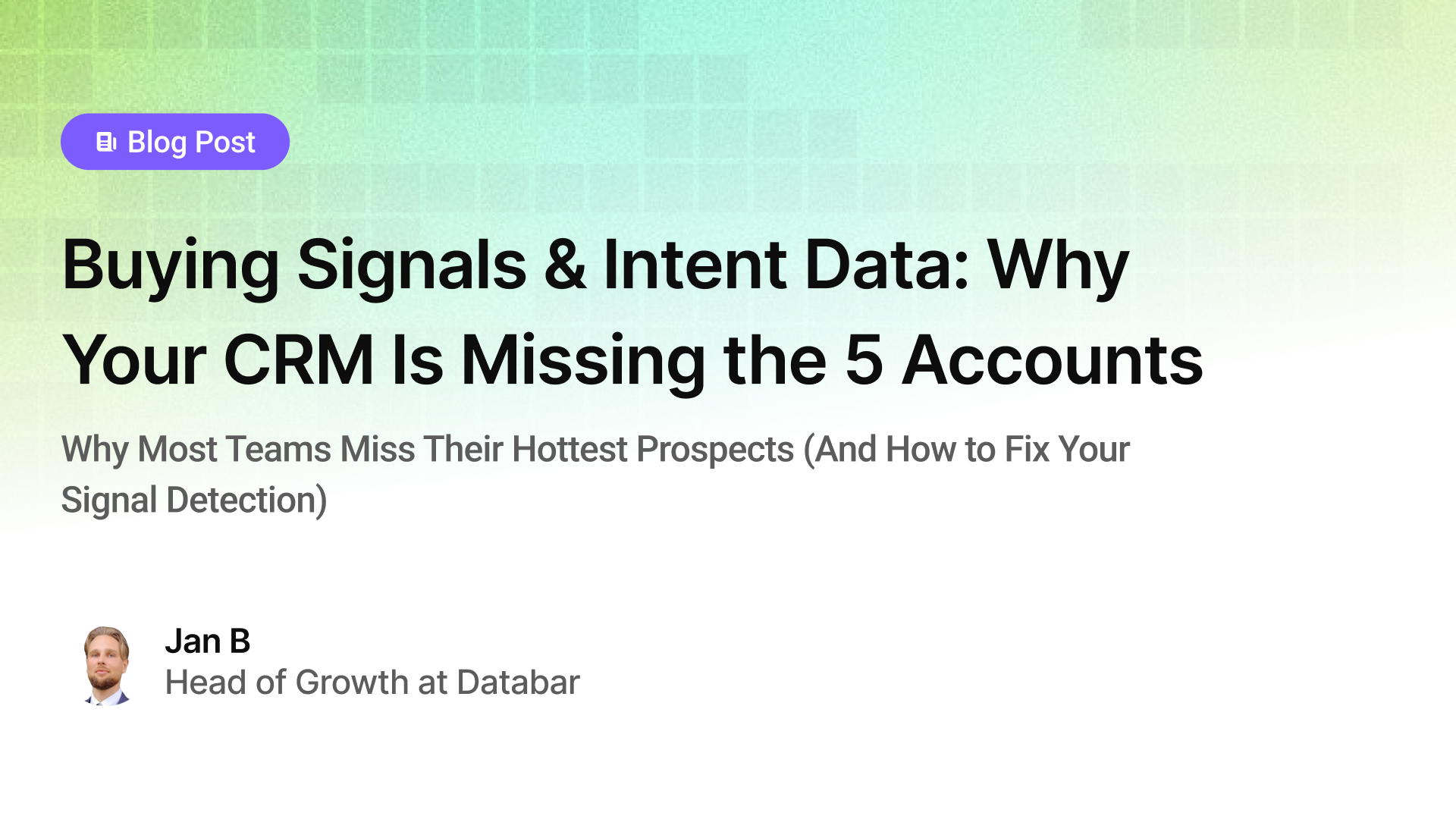
Buying Signals & Intent Data: Why Your CRM Is Missing the 5 Accounts
Why Most Teams Miss Their Hottest Prospects (And How to Fix Your Signal Detection)
by Jan, October 06, 2025

Lead Scoring & Account Segmentation: Why Most CRMs Get This Backward (And How to Fix It)
How to build a system that tells your team who to call, when, and why
by Jan, October 06, 2025
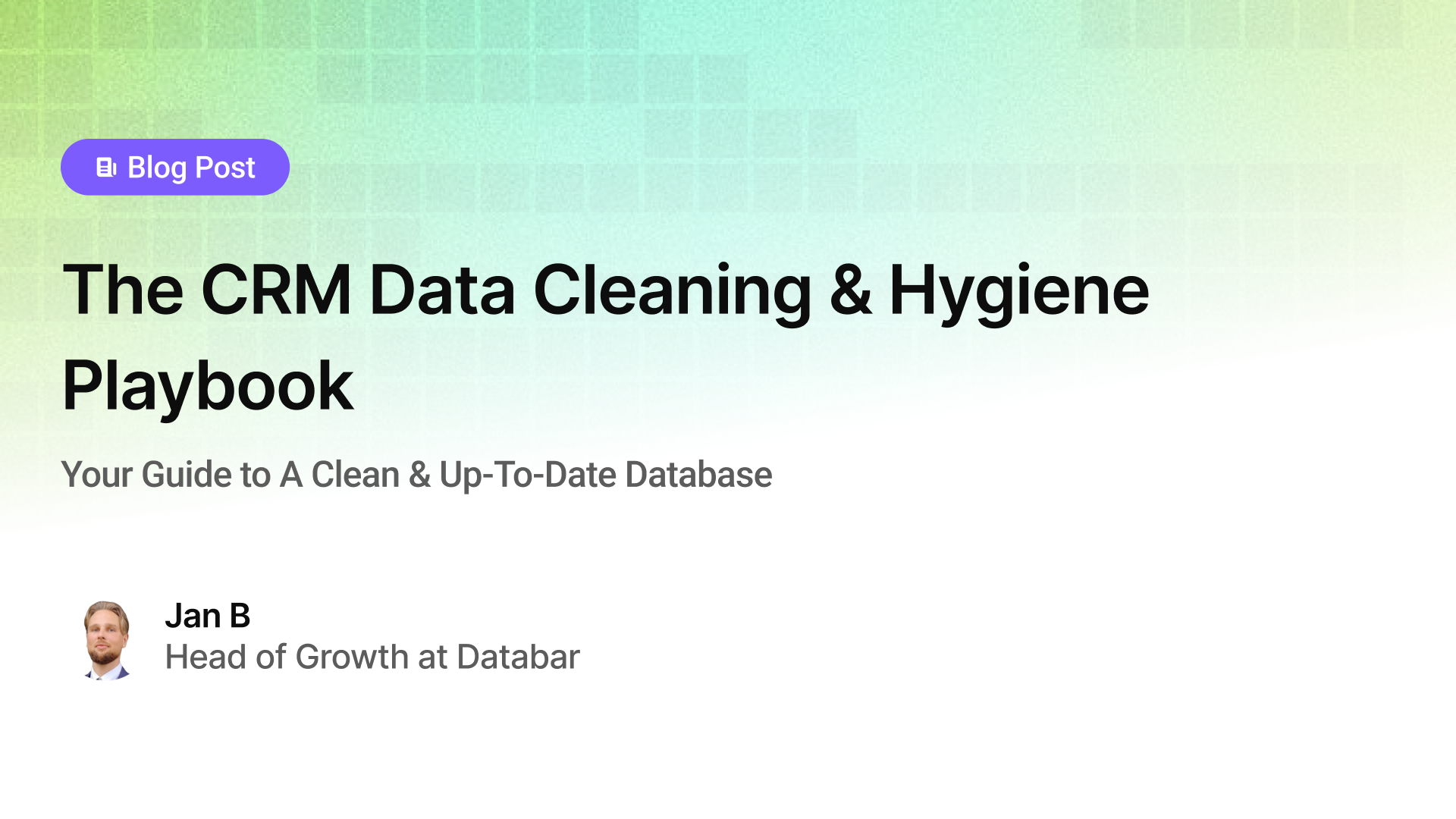
The CRM Data Cleaning & Hygiene Playbook
Your Guide to A Clean & Up-To-Date Database
by Jan, October 04, 2025
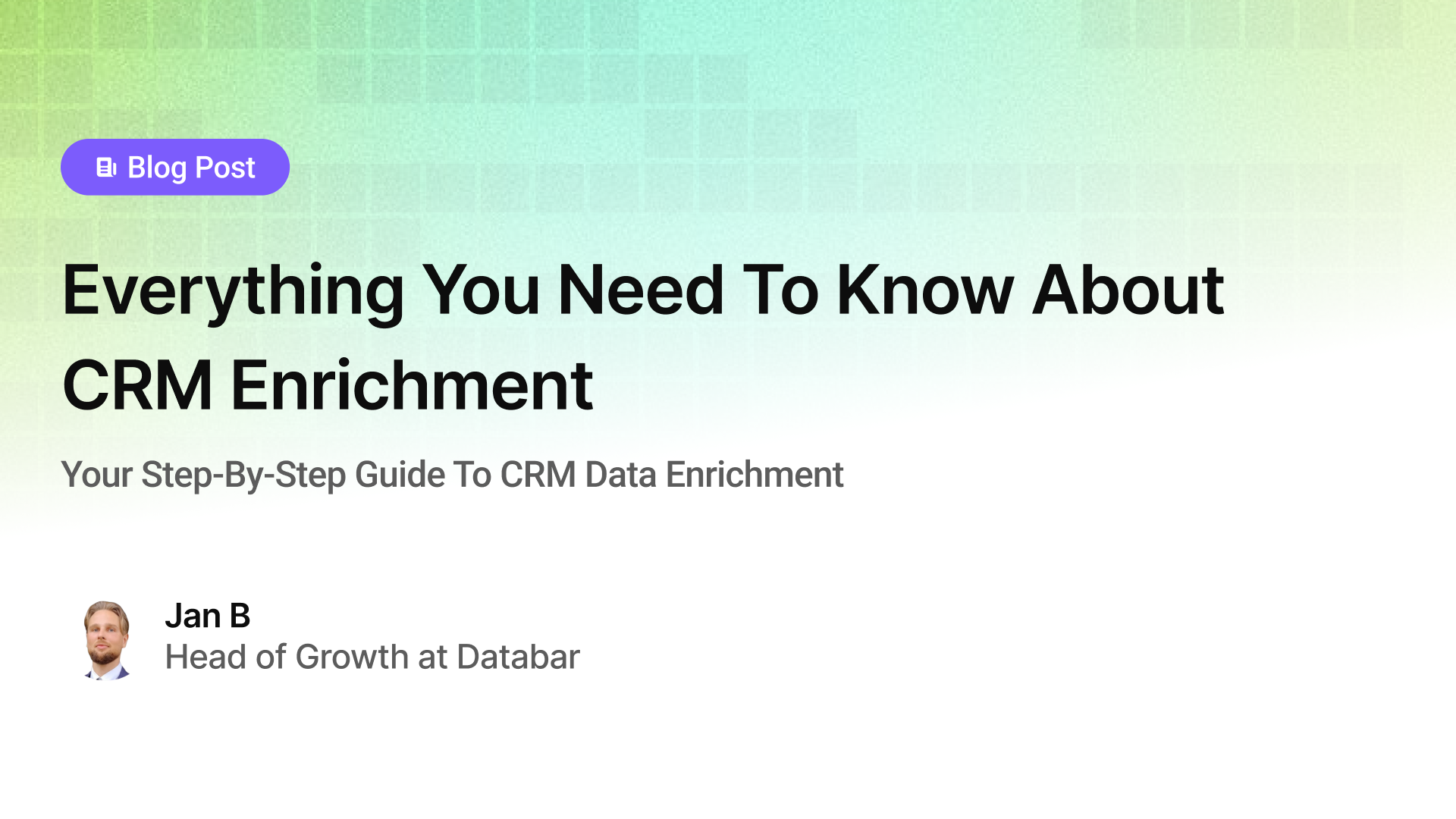
Everything You Need To Know About CRM Enrichment
Your Step-By-Step Guide To CRM Data Enrichment
by Jan, October 03, 2025

